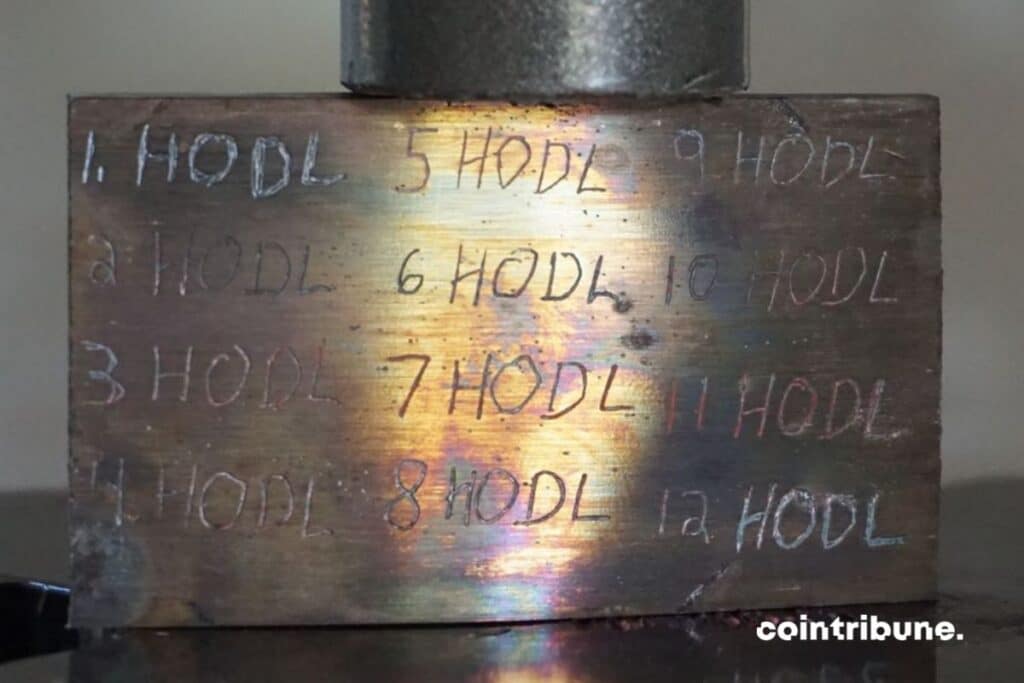Can someone discover my Bitcoin seed?
What is a seed? Is it possible for someone to guess it? What are the chances of that happening?

Seed
When you make the excellent choice of leaving exchanges, you’ll need to download a wallet beforehand (Wasabi, Electrum, Samourai, etc.).
Essentially, these wallets generate a “seed,” which consists of 12 words (or 24 words, depending on the wallet) chosen from a list of 2048 English words.
As long as you don’t lose this seed, you’ll always be able to regain access to your bitcoins. You should write it down on metal (there are plenty of solutions like cryptosteel) and bury it in your garden.
Example of a seed:
Fluid ancient satoshi rare zoo song object mother kick green human kitchen
For someone to take control of your bitcoins, they would have to discover these 12 words in the correct order. Is that possible? Yes. Is it probable? No.
Twelve words chosen from the same list of 2048 words means there are 2048^12 possible combinations.
That’s 5,444,517,870,735,015,415,413,993,718,908,291,383,296 combinations. In other words, 5444 sextillions of combinations.
In reality, it’s slightly less since the twelfth word of a seed is calculated from the previous eleven words. So, the actual number is 340,282,366,920,938,463,463,374,607,431,768,211,456 combinations.
If you could make 1 trillion guesses per second with a billion different computers, it would take over 10 billion years to exhaust such a number. That’s nearly the age of the universe.
To give you an idea, the probability of flipping heads a hundred times in a row is 1 in 1,267,650,600,228,230,000,000,000,000,000.
So, it’s 268 million times harder for an attacker to find your seed than to flip heads a hundred times in a row.
But there are more than one seed…
That’s right. So, the probability of finding any seed is actually higher.
Let’s imagine that each human has their own wallet. That would give us eight billion seeds. So, we need to divide the 340,282,366,920,938,463,463,374,607,431,768,211,456 possible combinations by eight billion.
The probability of finding a seed would then be 1 in 42,535,295,865,117,307,932,921,825,928.
It would take a billion computers capable of testing 1 trillion combinations per second to run for 1.3 years. That’s less than the age of the universe, but the probability remains zero.
Today, with a billion bitcoin addresses, we can assume that there are perhaps around 50 million seeds.
[Indeed, all addresses generated by a wallet derive from private keys that themselves derive from the wallet’s unique seed. We’ll come back to that.]
Therefore, we need to divide the 340,282,366,920,938,463,463,374,607,431,768,211,456 possible combinations by 50 million.
The probability of finding a seed today is about 1 in 6,805,647,338,418,769,269,267,492,148,635. That’s 215 years if we go back to our computer example.
We could also say that the probability of generating a seed that already exists is 1 in 6,805,647,338,418,769,269,267,492,148,635.
The lucky person would then end up with someone else’s BTC…
What is the seed used for?
The seed is the core from which a wallet creates private keys. And it is from these private keys that the famous Bitcoin “addresses” are generated.
It’s important to understand that there are no actual bitcoins in a wallet. It only contains private keys that allow you to move the BTC associated with them.
Bitcoins are technically unspent transaction outputs (UTXOs). There are currently around 80 million UTXOs whose list is maintained by each node in the Bitcoin network. They are fractions of bitcoin linked to a public key, which is in turn linked to a private key.
Each transaction (sending UTXOs) requires a valid private key (or multiple keys if the transaction contains multiple UTXOs). The public key is comparable to a bank account number, and the private key is like the PIN code of a bank card.
In a Bitcoin transaction, the recipient’s public key is represented by a Bitcoin “address” derived directly from their public key. Once the transaction is completed, only the recipient possessing the corresponding private key for that address will have control over the bitcoins.
Public key cryptography
There are two main families of cryptography algorithms:
- Symmetric algorithms, also known as secret key algorithms (a single key)
- Asymmetric algorithms, also known as public key algorithms (a private key and a public key)
Asymmetric cryptography lies at the heart of Bitcoin transactions. That’s where you should dig deeper if you want to better understand concepts like private keys, public keys, etc.
The first public key cryptography system was the RSA system, named after its inventors Ron Rivest, Adi Shamir, and Len Adleman. It was first presented in 1977 in the mathematical chronicle of the Scientific American magazine.
At its core lies the difficulty of factoring large prime numbers multiplied together. Here’s a great article if you’re interested.
The Bitcoin private and public key system, on the other hand, uses asymmetric cryptography based on elliptic curves. Did you enjoy this article? You’ll probably like this one on bitcoin mining.
Maximize your Cointribune experience with our "Read to Earn" program! For every article you read, earn points and access exclusive rewards. Sign up now and start earning benefits.
The Cointribune editorial team unites its voices to address topics related to cryptocurrencies, investment, the metaverse, and NFTs, while striving to answer your questions as best as possible.
The views, thoughts, and opinions expressed in this article belong solely to the author, and should not be taken as investment advice. Do your own research before taking any investment decisions.